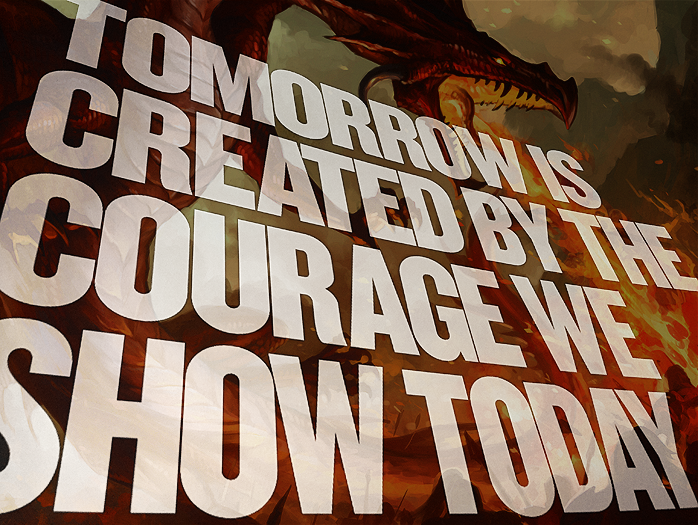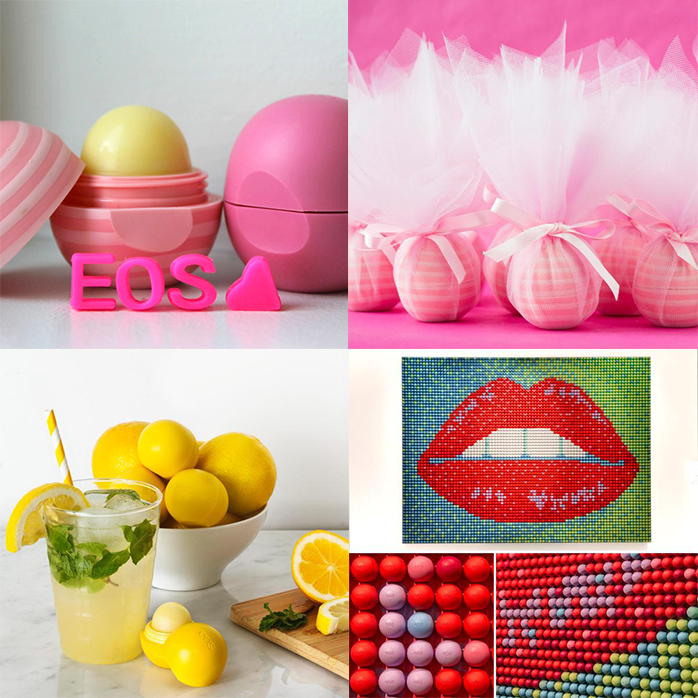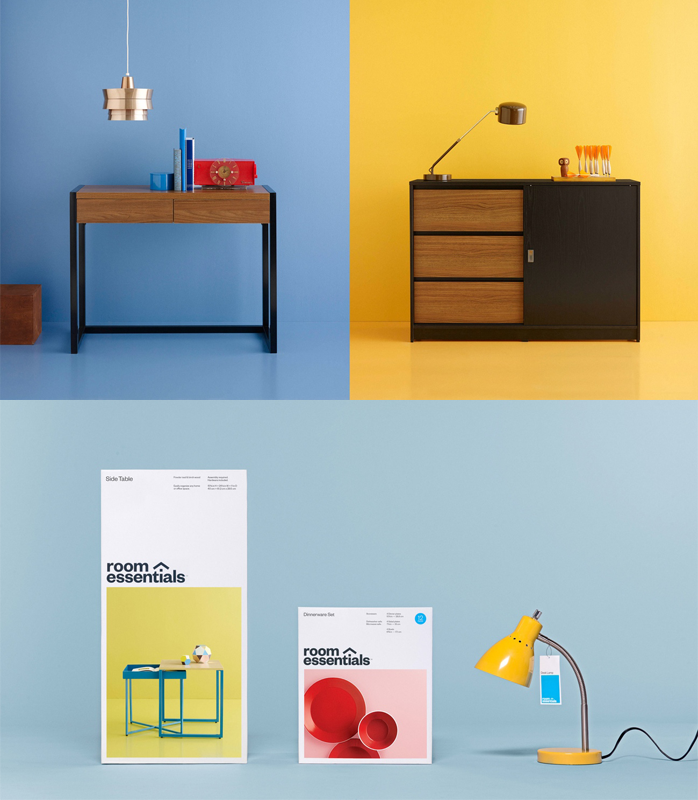When the executive creative director of one New York’s top branding agencies agrees to share his stories and advice on branding, you listen. You listen very closely. AIGA Houston invited Leland Maschmeyer, co-founder of Collins, to Houston Design Week and asked him to shed light on how his team faces challenges and how, as a company, they are always trying to push things further.
Dragon Slayer: Good Branding Takes Courage

For Leland, it all comes down to one simple idea founded on a bedtime story he was told as a child. A tale about kings, knights, maidens, bravery and in particular, dragons. Dragons have a prominent place in our culture. You’ll see them in our mythology to current trends as personal tattoos. To understand the reason why we have to look at what dragons do. There are three key things that you can count on dragons always doing. Capturing maidens, burning and incinerating nature, or guarding gold. Think about it. All these things are necessary for life to move forward. Whether that is biologically, environmentally or economically, yet dragons are preventing us from having access to them. The dragon is a classic metaphor for the life-denying problem that makes it impossible to grow, strengthen and go beyond our boundaries. When we do try and confront them, they do everything they can to intimidate us. So much that we don’t want to challenge them and would rather leave them where they are. Standing guard inside a dark cave controlling the limits of what is possible. Leland tells us it’s time we slay these dragons.
I can’t speak for every designer, but I empathize with Leland when he tells us we are more than explorers but in fact part of life. Unlike dragons, designers have chosen to create rather than control things, and we are focused on enabling life. We crave for the unbeaten path and believe that it will lead to better opportunities. We allow ourselves and others to flourish beyond the limits of what currently confines them. We do this for businesses, individuals and communities, and this is what drives the heart of design. But for this to happen, we must charge forward and enter into the cave of unknown. Trepidation is part of new projects, but being a dragon slayer is about being fearful yet choosing to act and to move into a space that no one else has before and solve a problem that no one else has figured out how to solve. Designers are warriors.
Now, let’s be realistic. There are many dragons out there. There are obstacles that really hold us back. And this is where it gets good. During Leland’s professional experience, he and his team have faced huge challenges. Sorry to spoil the ending but they manage to defeat all the dragons in this story. Here’s how they do it.

If you are going up against a dragon, you should avoid where it’s strongest and attack where it’s weak.
EOS, a skin care brand that I’m sure you’re familiar with, came to Collins and asked them to help the company move into the lip balm industry. At the time, Chapstick, a product backed by the giant corporation Pfizer, dominated the sector. Collins realized they were up against a fire-breather whose marketing budget was tremendously larger compared to EOS. Leland and his team went to work and began to try and determine how the packaging could differentiate EOS from Chapstick. To start, they asked a few women how they use lip balm and where they normally keep it. Out poured the contents of their purses and something interesting happened. The Chapstick tube was similar in shape to many other things inside the purse. Makeup, highlighters, instant stain remover and all the other similar shaped items made it harder to find the only thing you were actually looking for. So there it was. Changing the form could take them to victory. Collins merged the two common forms of lip balm, the tube and the jar, together to create an original shape that made it unique and easier to locate. They kept the design simple, basic and purposely chose bright colors to make it appealing to their audience.
Leland describes two types of packaging we see on the shelves when we shop. One is designed to say, “buy me” and the other, “live with me.” When designing a product or brand, he and his team understand they are contributing something to someone’s life or home. Today, customers are still in frenzy for EOS and are creatively finding ways to integrate the product with their lives. It’s now the number one lip balm in North America.


Learn the dragon’s principles and use them to create.
Target-owned Room Essentials was experiencing drops in sales quarter after quarter. The lack of well designed packaging and confusing brand was turning customers the other way. Originally, Room Essentials, or “RE” at the time, was labeled as dorm furniture and appealed to college students on a low budget. Fortunately, the product was undergoing a revamp and the furniture would become more modern and better looking. The company wanted to shift their target onto young professionals moving into their first home. Now, not everyone is design savvy, but homeowners still want to nicely furnish their home and have something that looks well designed. To begin searching for ideas and expertise, most Millennials jump online. And where do they end up? Pinterest. (If you haven’t ever browsed through the digital cork board, don’t start now. It’s addictive.) A majority of the search results have a very specific visual aesthetic. The images tend to be modern and minimal, and everything is shot in the same way—notably with interior design. These become the cues and customers take the pins with them down the store aisles and attempt to mimic them. For many customers, building on their inspiration from what they see on the shelves is difficult, and it becomes frustrating. To solve the problem, Leland and his team took the larger customer journey approach to the design and integrated how the consumer shops. They applied the art direction found on Pinterest to the new Room Essentials product photography. The new packaging was easier to see with its bright colors, negative space and most importantly, large simple photography that emulated the inspiration. Customers now had an easier time piecing together the big picture while they shopped.
Leland compares it to a classic concept in mythology where a hero can only succeed if they use the tools of their adversary. The next time you’re up against a challenge, find out what the opposite team is doing and flip it to your benefit.


Train your dragon.
I related to this challenge the most. Every project has guidelines but sometimes there is that one rule set by the client that breaks a designer’s creative spirit and all we see is failure. Leland experienced that too when Solid Gold, a dog food company founded in the 1970s, had been squeezed off the shelves by trendy scientific organic brands and went looking for help to jolt back into the market. Collins went back in time for inspiration and came up with an agreeable direction. The design called for unique illustration and the intent was to find a talented illustrator for this particular style. Not long after Collins came up with a worthy list of candidates, the dog food company told them they had an illustrator they wanted the agency to work with instead. The horror came after Collins flipped through the illustrator’s portfolio. The style of this illustrator was completely divergent of the intended design. Leland and his team, like many teams of designers, automatically went into defense mode and fought to protect the work. The client insisted they use this illustrator, so Collins had to find a way to make this work. After clear communication of the ultimate goal, persistent guidance and good feedback, everyone landed on the same page. Solid Gold’s packaging had the right balance of abstractness and formalness and eventually tripled their shelf space.
Leland explains that this success wasn’t about marketing or big budgets. It was about a company who used design strategically to overcome a very difficult and complex situation they didn’t know how to solve on their own. Sometimes you don’t need to slay the dragon, but dedicate time in training it the right way. Not everything is an adversary just because it’s difficult at first.

It can be a scary and intimidating place when no else has had the courage to venture out and try something no one knows how to solve. Conflicts and confrontations will be difficult but the rewards are worth it once you find a way to overcome them. Like Joseph Campbell, a popular American writer, Leland believes that aesthetic disciplines found in art, literature and philosophy are to be used as tools to help us push past our limited horizons so that we can continue to grow and strengthen. The more we defeat dragons the more we experience transformation and expansion. And the further we push ourselves the bigger chance we’ll have at creating more awareness and opportunity. Sharpen your blades, comrades. We’re going in.





